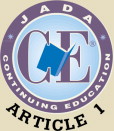Aerosols and Splatter article published by JADA
Aerosols and splatter in dentistry
A brief review of the literature and infection control implications
STEPHEN K. HARREL, D.D.S.
JOHN MOLINARI, Ph.D.
DOI:https://doi.org/10.14219/jada.archive.2004.0207
ABSTRACT
Background
Aerosols and droplets are produced during many dental procedures. With the advent of the droplet-spread disease severe acute respiratory syndrome, or SARS, a review of the infection control procedures for aerosols is warranted.
Types of Studies Reviewed
The authors reviewed representative medical and dental literature for studies and reports that documented the spread of disease through an airborne route. They also reviewed the dental literature for representative studies of contamination from various dental procedures and methods of reducing airborne contamination from those procedures.
Results
The airborne spread of measles, tuberculosis and SARS is well-documented in the medical literature. The dental literature shows that many dental procedures produce aerosols and droplets that are contaminated with bacteria and blood. These aerosols represent a potential route for disease transmission. The literature also documents that airborne contamination can be minimized easily and inexpensively by layering several infection control steps into the routine precautions used during all dental procedures.
Clinical Implications
In addition to the routine use of standard barriers such as masks and gloves, the universal use of pre-procedural rinses and high-volume evacuation is recommended.
The production of airborne material during dental procedures is obvious to the dentist, the dental team and the patient. An aerosol cloud of particulate matter and fluid often is clearly visible during dental procedures. This cloud is evident during tooth preparation with a rotary instrument or air abrasion, during the use of an air-water syringe, during the use of an ultrasonic scaler and during air polishing. This ubiquitous aerosolized cloud is a combination of materials originating from the treatment site and from the dental unit waterlines, or DUWLs. It is common for the patient to comment on this cloud of material. With the advent of severe acute respiratory syndrome, or SARS, questions concerning the potential for the spread of infections from this aerosol may arise.
In this article, we review relevant literature that has addressed the presence and makeup of dental aerosols and splatter. We also assess the threats that may be inherent in this airborne material, including risk potential to patients and the dental team. We make recommendations for the control of dental aerosols and splatter.
Read full article here:
